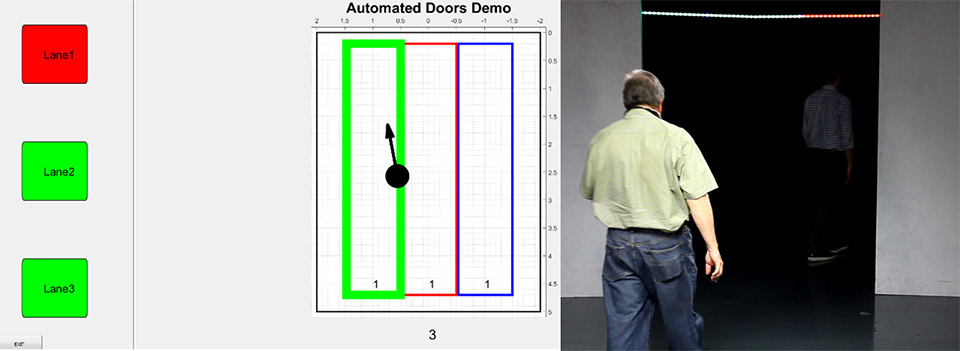SSZT479 may 2019 IWR6843
In a world quickly moving towards smart cities, factories and buildings, entrance systems cannot afford to lag behind. Entrance systems of the future, such as automated sliding doors, turnstiles and parking barriers will use sensor-driven solutions to allow their systems to operate with intelligence, efficiency and convenience. TI’s millimeter wave (mmWave) sensors address the key challenges that entrance system designers face. mmWave sensors help solve major challenges for automated sliding doors, parking barriers and industrial/garage doors as shown in Figure 1.
TI’s millimeter-wave (mmWave) sensors address the key challenges such as false detections and system complexity that entrance system designers face. mmWave sensors help solve major challenges for automated sliding doors, elevator doors, revolving doors, parking barriers and industrial/garage doors. Figure 1 shows three examples of automated entrance systems.
 Figure 1 Various automated entrance
systems including a) a garage door opening based on vehicle height, b) a sliding
door avoiding a false detection and c) an intelligent parking barrier that
filters out non-vehicles approaching gate.
Figure 1 Various automated entrance
systems including a) a garage door opening based on vehicle height, b) a sliding
door avoiding a false detection and c) an intelligent parking barrier that
filters out non-vehicles approaching gate.Benefits and Features of mmWave Sensors
TI mmWave sensors help enable intelligent decision-making for various entrance systems by providing critical information such as range, velocity and angle of arrival of multiple objects in a scene by leveraging 3D point cloud information and an on-chip digital signal processor. Since mmWave sensors operate with a wide 4-GHz bandwidth, they can identify and separate objects that are as close together as 4 cm.
For entrance systems – turnstiles in particular, where people are counted as they individually move through the gate – high-resolution capability is necessary in order for the sensor to accurately count and identify objects or people. In the case of industrial or garage doors, leveraging 3D point cloud information can also determine the height of approaching people or vehicles, enabling efficient operation. Because the system does not use optical sensors or cameras, all personal information about a person in a scene remains private.
mmWave sensing is robust to outdoor conditions such as bright sunlight, darkness, fog, smoke and rain. The technology can also sense through plastics and drywall and can thus be hidden in installations to enable cleaner industrial designs. Figure 2 shows a single mmWave sensor intelligently detecting a person’s intent when walking toward multilane door.
 Figure 2 A TI mmWave sensor tracking a person walking toward a multilane door
Figure 2 A TI mmWave sensor tracking a person walking toward a multilane door| Start designing with the automated doors reference design using TI mmWave sensors | |

|
 Download the reference design here
Download the reference design here
|
How TI’s mmWave Sensors Solve the Challenges of Today’s Entrance Systems
Let’s explore how TI’s mmWave sensors can help solve challenges associated with the design of automated sliding doors, parking barriers, and industrial and garage doors.
False Detections
False detections are occurrences where an automated entrance opens for a person or vehicle that wasn’t intending to move through it. For example, if an automated entrance opens for a shopper who was only walking past the entrance, not through it, this act not only impacts the power consumption of the entrance system because the entrance opened unnecessarily; it also affects energy efficiency by allowing warm or cool air in or out of the area of interest.
TI’s mmWave sensors leverage a rich 3D point cloud along with position and velocity information to determine the intended direction of a moving object, thus avoiding false detections.
Static Object Detection
Entrance system designers need to consider how best to prevent harm in incidents where certain objects like a cart, box or even a child are left in the pathway of a door. TI’s mmWave sensors have an on-chip processor that runs algorithms that detect the position of non-moving objects within the sensor field of view. The system can then make a decision, like keeping doors open, ensuring reliable operation of automated entrance systems.
System Complexity
On-chip integrated processing also enables precise, accurate monitoring of multiple lanes or gates that experience heavy traffic with a single sensor, reducing overall system complexity and cost. In specific entrance system applications that require the coverage of multiple lanes or gates, more complex systems require longer design times and higher costs. Most existing sensing technologies require multiple sensors, and thus a more complex and costly system, to be able to monitor particular zones and multiple objects or people in a scene.
Convenience and User Experience
Convenient operation of entrance systems for day-to-day users is another challenge; for example, if a person runs toward an automated door but has to slow down because the door did not open in time. By leveraging range, velocity and angle of arrival information, TI’s mmWave sensors enable systems to operate intuitively based on user interaction.
Conclusion
When used in automated entrance system applications, TI mmWave sensors intelligently reduce false detections, detect static objects, minimize system complexity and provide a convenient user experience. The sensor’s ability to perform in a variety of environmental conditions and track people and motion without capturing identifiable information makes it flexible for use in both indoor and outdoor settings.
Additional Resources
- Experiment with the automated doors lab, including all relevant software.
- Watch the video “Automated doors with TI mmWave sensors.”
- Read the technical article “Designing the elevators of the future.”
- Read the white paper “Bringing intelligent autonomy to fine motion detection and people counting with TI mmWave sensors.”